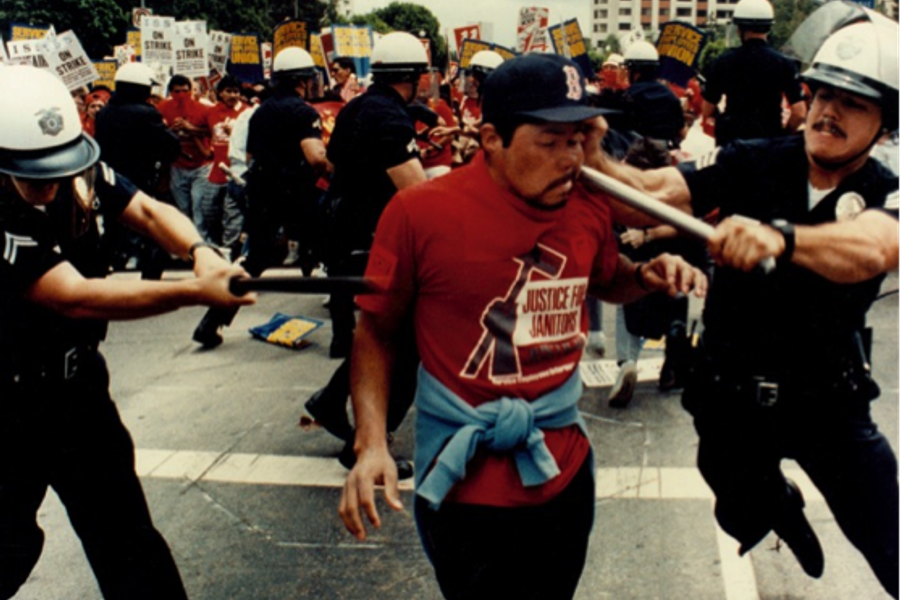25 Years Later: Lessons From the Organizers of Justice for Janitors
Stephen Lerner and Jono Shaffer

This article was originally published at TalkPoverty.
On June 15, 1990, the Los Angeles Police Department viciously attacked immigrant janitors who were striking for the right to organize in Century City, Los Angeles. In a story that is now all too familiar, the police claimed they were defending themselves. Only later, when TV news footage exposed the police clubbing non-violent strikers, was the self-defense claim discredited. Two women miscarried, dozens were hospitalized, and 60 strikers and supporters were jailed.

After the violence, the workers regrouped in a nearby park where one of the strikers said, “What they did to us today in front of the TV cameras, is the way the police treat us every day.” Another woman striker told a reporter, “I wasn’t robbing a bank or selling drugs, I’m simply asking for an increase in pay but the police beat us as if we were garbage.”
However, the police assault backfired, and the response of the campaign organizers and activists is still instructive today. Far from being beaten into submission, the strikers met the next day and voted unanimously to return to the scene of the violence on the following day.
Over the next weeks, public outrage at the police helped galvanize support for the strikers. Janitors in Century City won their union, doubling their pay and benefits. Century City also proved a tipping point for the Justice for Janitors campaign. Many in the labor movement had argued that janitors were impossible to organize — they were undocumented, part-time, subcontracted, workers of color — but the campaign demonstrated clearly that not only could these workers organize, they could win.
Emboldened by success in Century City, Janitors in Washington, D.C., blocked the 14th Street Bridge with school buses, effectively shutting down the nation capital’s rush hour commute.

At the University of Miami, janitors fasted for weeks as part of their lengthy and winning strike. Workers in wheel chairs, weakened by the fast, surrounded the university’s president Donna Shalala and chanted in Spanish, “Union or death!” In Houston, 5,000 Janitors won a first-time union contract in a “right-to-work” state, despite the fact that bail was set at more than $20 million for people arrested for non-violent acts of civil disobedience in the city. Workers in cities across the nation went on strike in support of the Houston janitors, and allies in Europe occupied buildings. Finally, pension fund trustees in charge of $1 trillion in workers’ pension fund capital adopted “responsible contractor” procedures — committing to invest only in office buildings where janitors were treated fairly.
The Justice for Janitors campaign succeeded because it relentlessly went after the building owners and financiers at the top of the real estate industry — the people who truly had power over the janitors’ livelihood — not the cleaning companies who were powerless subcontractors. The campaign also exposed an economy that was increasingly using sub-contracting and other schemes to separate and isolate workers from the corporations and companies that were actually in control of their wages, benefits and overall working conditions.
Justice for Janitors became much more than a “union organizing campaign,” it grew into a movement. Its influence and impact extended far beyond the people directly involved in the campaign’s actions. Its success was rooted in its ability to pit the needs of an entire community against the wealth of the real estate industry. The movement penetrated pop culture with Adrian Brody starring in Bread and Roses, a movie based on the Century City Strike. The game show Jeopardy asked contestants, “What is Justice for Janitors?” The campaign was also part of the back-story of the assistant in The Devil Wears Prada. The Justice for Janitors movement became a living example of what was possible — even against the greatest odds.
Hundreds of articles and dissertations have now been written about the keys to the success of the campaign. Some claim that it succeeded through militant direct action, strikes and disruption rooted in the struggles of Central America. Others state it was through grounding organizing in immigrant communities. Still others say it was due to integrating existing union membership with non-union workers. Additionally, some view global solidarity, corporate leverage, and “top-down” tactics as the basis of the campaign’s success.
As two of the original organizers of Justice for Janitors — with 25 years of distance from the Century City Strike — the key lesson for us is that there is no silver bullet; there isn’t one thing, one strategy, one action, or one tactic that magically beats billionaires or creates the space for a movement to develop.
Yet Justice for Janitors unquestionably provides critical lessons for future organizing: As Wall Street and the finance industry increasingly take control over the global economy, we have to look up the economic food chain and target the real culprits. We have to bring as many stakeholders to the fight as possible, and creatively and aggressively organize to disrupt business as usual for those in control — that can mean strikes, civil disobedience, engaging shareholders, or directly challenging other business, social, and political interests and their exploitative practices and schemes.
Workers’ lives have been disrupted enough. It’s time to turn the tables.




